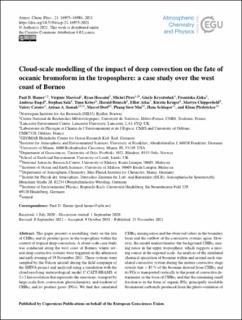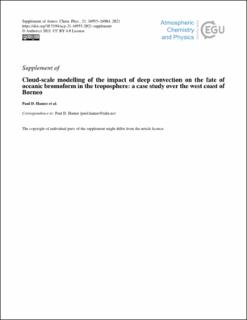| dc.description.abstract | This paper presents a modelling study on the fate of CHBr3 and its product gases in the troposphere within the context of tropical deep convection. A cloud-scale case study was conducted along the west coast of Borneo, where several deep convective systems were triggered on the afternoon and early evening of 19 November 2011. These systems were sampled by the Falcon aircraft during the field campaign of the SHIVA project and analysed using a simulation with the cloud-resolving meteorological model C-CATT-BRAMS at 2×2 km resolution that represents the emissions, transport by large-scale flow, convection, photochemistry, and washout of CHBr3 and its product gases (PGs). We find that simulated CHBr3 mixing ratios and the observed values in the boundary layer and the outflow of the convective systems agree. However, the model underestimates the background CHBr3 mixing ratios in the upper troposphere, which suggests a missing source at the regional scale. An analysis of the simulated chemical speciation of bromine within and around each simulated convective system during the mature convective stage reveals that >85 % of the bromine derived from CHBr3 and its PGs is transported vertically to the point of convective detrainment in the form of CHBr3 and that the remaining small fraction is in the form of organic PGs, principally insoluble brominated carbonyls produced from the photo-oxidation of CHBr3. The model simulates that within the boundary layer and free troposphere, the inorganic PGs are only present in soluble forms, i.e. HBr, HOBr, and BrONO2, and, consequently, within the convective clouds, the inorganic PGs are almost entirely removed by wet scavenging. We find that HBr is the most abundant PG in background lower-tropospheric air and that this prevalence of HBr is a result of the relatively low background tropospheric ozone levels at the regional scale. Contrary to a previous study in a different environment, for the conditions in the simulation, the insoluble Br2 species is hardly formed within the convective systems and therefore plays no significant role in the vertical transport of bromine. This likely results from the relatively small quantities of simulated inorganic bromine involved, the presence of HBr in large excess compared to HOBr and BrO, and the relatively efficient removal of soluble compounds within the convective column. | en_US |


